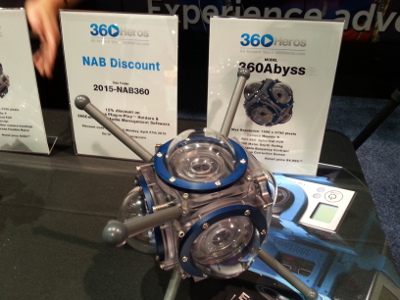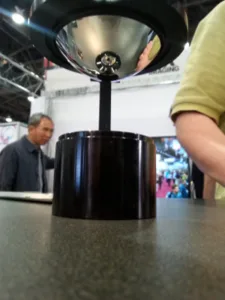There were a lot of developers of 360-degree camera or software companies at NAB – all to feed the growing need for virtual reality content.
RTI
The benefit of a one-camera 360-degree capture option is the lack of stitching required for multi-camera solutions. On the other hand a single camera solution must spread the limited sensor pixels over the field of view. RTI was at NAB showcasing its single camera solution.
RTI uses a specially designed spherical mirror that captures the image to a 4k sensor from AltaSense. The uncompressed 4k/30 fps image is output at the cameras as Quad-SDI, but transmitted over fiber and back to SDI if located some distance from the processing engine. RTI has developed its own video format for this transmission to the processing unit, where it can be readied for streaming to the Internet.
The company has about 15 videos it has prepared for the Samsung GearVR which are available on the Milk VR site.
360Heros
360Heros had a 40’ (12m) tour bus in the North Hall at NAB 2015 where it was showcasing a variety of camera module. The company focuses mainly on rigs for GoPros offering 3D printed holders for a plethora of configurations. Most are 2D rigs with varying numbers of cameras and some are stereo rigs. New at the show was a new dome that goes over each camera for underwater applications rated to 130 feet (40m) ($2,395).

A 7-camera circular array is $595, while a 10 channel circular array is $745. For 3D capture, there is a 12 camera rig for $995. You also have to buy the GoPros.
For software, the company resells stitching software from Kolor and VideoStitch. CamMan 2 prepares the files for color matching and finishing for web posting. Color matching needs to be done in another program like AfterEffects. There is also a new SD card reader that can ingest multiple files in parallel.
The company thinks perhaps 75% of its customers are using the rigs for commercial or professional use with the minority used by hobbyists.
Fraunhofer IIS
Fraunhoffer IIS showed off its Omnicam solution, which is a 10 segment camera with upward facing 1080p cameras and segmented mirror array. New for NAB was the ability to define a segment of the panoramic image to extract for broadcast or other uses.
The company noted that interest in its solution has skyrocketed recently because of the interest in creating content for VR. The solution is in 2D, but the company is now looking at creating a stereoscopic version of the rig.

Bublcam
Bublcam is a Toronto company that is developing a consumer focused 360 camera. The device is just about ready to ship now.
The company has its own stitching algorithm and is looking at new sensors for follow-on models. It is also looking at applications where the 360-degree feed becomes a second screen use model for an event on the primary screen. This might be a 360 advertisement for a sporting event, for example. The company is also talking to set designers who can better visualize the set up prior to constructing the set.
Lucid
Lucid has developed a two-camera device that looks like a stereo camera, but is actually a 180-degree capture device. Each camera captures at FHD resolution and it has a maximum field of view of 210 degrees. You can use two of the devices back to back to capture a 360-degree image.
Pricing has not yet been determined but it is aimed at the consumer market, so less than a few hundred dollars seems reasonable.
Legend 3D
Perhaps the most impressive demo was one by Legend 3D – a post production house best know for converting major Hollywood movies from 2D to 3D. Now, it is applying its skills and a modified workflow to create high quality stereoscopic 360-degree content.
The starting point for the company is usually a 360-degree video in 2D that has been stitched together for VR viewing. What Legend3D does is a series of steps to correct stitching errors and generate stereoscopic pairs for the VR headsets. This is a very intensive process that requires the full 2D-to-3D pipeline with additional steps for the stitching error correction and visualization in the headset. The company finds that review of the planar image does not find all the subtle errors that are visible in the headset image, so there is a lot of back and forth.
One clip showed an interview with a woman who would appear and disappear, with changing backgrounds. One very nice effect was that she went flat just as she disappears from the scene.

